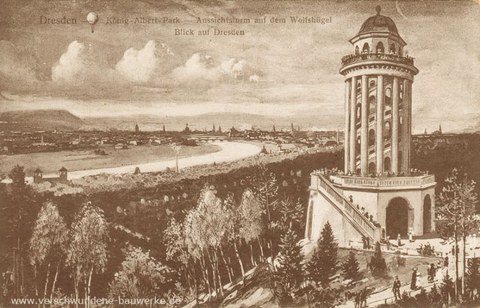Good prospects at the Wolfshügelturm
Table of contents
Project data
| Titel | Title Gute Aussichten am Wolfshügelturm | Good prospects at the Wolfshügelturm Förderer | Funding Wiederaufbau Wolfshügelturm e. V. Zeitraum | Period 09.2019 – 10.2019 Leiter | Project Manager Prof. Dr.-Ing. Wolfram Jäger, Professur für Tragwerksplanung, TU Dresden Bearbeiter | Contributors Dipl.-Ing. (FH) Sabine Wellner, Dr.-Ing. Torsten Hampel Versuchsdurchfühung | Test execution Dr.-Ing. Sebastian Wilhelm, IBB Ingenieurbüro Baustatik Bautechnik, Dresden |
Report in the annual report 2019
FAST WIE IM FILM - GÖRLITZER KAUFHAUS
The Otto Mohr Laboratory has already carried out a large number of investigations at extraordinary locations in recent years. This year, the OML was directed to conduct material testing at the Wolfshügelturm in the Dresdner Heide.

Extraction of drilling cores
The term Wolfshügel refers to wolf gardens, in which until the time of the Thirty Years War, wolves were kept for hunting by the Saxon Royalty. The first Wolfshügelturm was built in 1886 as a wooden structure and was only 4.30 meters high. Nevertheless, the tower quickly became a popular destination, as it offered a spectacular view of the landscape and the Dresden Elbe Valley. Due to constant repair works on the wooden tower, the city council of Dresden decided in 1911 to build a massive reinforced concrete tower. The project management was the responsibility of Professor Hans Erlwein, a member of the city council. The octagonal substructure was supported on an 80 cm thick concrete foundation. The substructure was used as a storage room with four large arched entrances and two exposed exterior stairs. The actual tower had arch-shaped windows, 14 half-columns on the outside and two nested spiral staircases, which led to the 12 m high viewing area under a copper-covered dome. The building was completed in 1912. During World War II, the tower served military purposes, and it was also used as a news station after installation of a radio mast. On May 7th, 1945, the tower was blown up by units of the SS, before the invasion of the Red Army.

Postcard of the Wolfshügelturm around 1912
The Otto Mohr Laboratory was commissioned to carry out various material investigations in-situ and in the laboratory on the remaining parts of the substructure. Thus, for example, the construction of the outer walls, the layer structure as well as the compressive strength of the concrete was determined by means of core drilling. Furthermore, a reinforcement scanner was used to determine the position and diameter of the rebar in the connection areas of the former half-columns. Finally, the determination of the adhesive tensile strength and the degree of carbonation of the reinforcement was carried out.
The positive results are now being examined by the “Wiederaufbau Wolfshügelturm e.V,” an association founded in 2018 by construction experts, fundraisers and creative minds.
